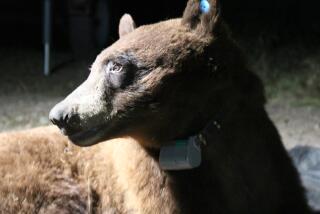Poachers Encroaching on North America for Bear Parts
- Share via
VANCOUVER, British Columbia — The black bears that roam Canada’s vast backwoods have a new enemy these days, half a world away.
In the pharmacies and restaurants of cities like Hong Kong and Seoul, customers flush with money from East Asia’s economic boom are paying premium prices for bear-claw soup and medicines made of bear gallbladders.
Until recently, there were enough bears in China and Russia to meet the demand. Now, those populations are dwindling, and traffickers in bear parts are turning their attention to North America--the black bear’s last bastion.
Across Canada, wildlife conservation experts are sounding the alarm as bear poaching increases. Behind many of the killings are underworld groups, operating out of Vancouver’s fast-growing Asian community, that find trafficking in bear parts to be as lucrative, and less risky, than drugs.
“This is the first time a North American animal has been targeted by interests largely outside our continent,” said Michael O’Sullivan, executive director of the Humane Society of Canada. “We have to do something now.’
For the moment, Canada’s black bear population remains healthy--an estimated 300,000 to 400,000. But conservationists calculate that up to 40,000 are being poached each year, a rate too high to be offset by births.
“If the pace keeps going over the next five years, we will fundamentally lose the species in the wild and have only isolated populations left,” O’Sullivan said.
Conservationists are urging authorities to act before a crisis arrives--they want tougher penalties for poaching and trafficking and more resources devoted to wildlife protection. The handful of traffickers convicted recently generally received fines that could be recouped with the sale of a few gallbladders.
“The middlemen can easily make a tenfold profit in this business,” said Mark Hayden, a conservation officer with the British Columbia Environment Ministry. “The penalties [a maximum fine of 10,000 Canadian dollars, or $7,500 U.S.] are enough only to deter small-time poachers. We need penalties to deter the hard core.”
The profit potential is enormous. Tiny quantities of bile from bear gallbladders can sell for far more than the equivalent price for gold, or cocaine, in Asian markets. Diners at some Asian restaurants will pay hundreds of dollars for a bowl of bear-claw soup, considered a delicacy.
Wildlife protection agencies say they do not have the money or manpower to defeat the trade in animal parts, but they have managed a few high-profile undercover operations.
In Vancouver, conservation officers seized 191 gallbladders in one raid last year and in another found 84 declawed bear paws in a basement freezer.
“This business has a lot of similarity to drug trafficking--some of the people are the same, but the risks are less,” Hayden said.
One of the difficulties fighting the poachers and traffickers in Canada is that regulations are a matter for each province to decide. Only British Columbia and Manitoba have banned both the sale and possession of bear parts; in Quebec and Nova Scotia, both sale and possession are legal.
Conservation groups say that without a uniform ban across Canada, the trade in bear parts will be extremely difficult to combat, especially since there is a legal bear hunt in Canada. Wildlife experts estimate that for every bear killed legally, two are killed illegally. About 20,000 to 25,000 bears are killed annually by hunters who purchase special licenses.
In addition to seeking tougher enforcement and penalties, conservation groups and wildlife authorities are trying to convince the Chinese community in Canada that the trade in bear parts should stop.
One of the few Chinese Canadians taking a lead role in combating the trade is Anthony Marr, a Hong Kong native who works with the Vancouver-based Western Canada Wildlife Committee.
One of his tactics is to address Asian immigrant schoolchildren in the Vancouver area, where about one-fourth of the 1.6 million people are from Asia. He hopes that the children will help change the attitudes of their parents and that in the long run a new outlook in Vancouver could start a ripple effect in other Asian communities.
“It’s wishful thinking to think we can hold these species steady,” Marr said. “But if we can buy 10 years of time, hopefully the culture can shed some of these old ways that have become environmentally unsound.”
Marr says he has dual motivations--to protect the animals and bolster the reputation of his own Chinese community.
“If the Chinese really want to be modern, on par with the West, we have to do a lot of soul searching,” he said. “If we carry on the way we have been, and drive major species to extinction, we’ll really be spat upon by the rest of the world.”
“The Chinatown businessmen wouldn’t change their ways for humanitarian reasons or a love of nature--only if you change the law,” he said.
Unlike rhinoceros horn, which has a mythical reputation as an aphrodisiac, bear gallbladders have proven medicinal value. They produce ursodeoxycholic acid, which is used in traditional Chinese medicine to treat intestinal, liver and cardiac-related diseases.
Synthetic substitutes are available, but profit margins are much higher for real bear-gall products.
More to Read
Sign up for Essential California
The most important California stories and recommendations in your inbox every morning.
You may occasionally receive promotional content from the Los Angeles Times.













